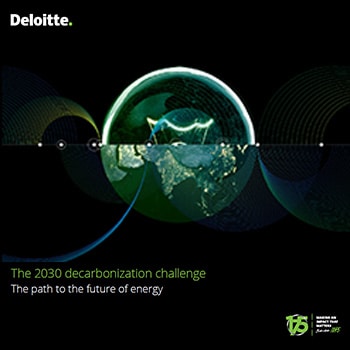Article

The 2030 decarbonization challenge
The path to the future of energy
The global energy mix is shifting from fossil fuels to renewables. There are abundant examples of both public and private organizations working hard to decarbonize the economy. As this energy transformation or “Green Deal” gains momentum, new ecosystems are forming and new technologies are emerging. These developments are helping to grow renewables, develop new energy carriers, improve energy efficiency, reduce emissions and create new markets for carbon and other by-products as part of an increasingly circular economy. At the same time many of these commonly pursued steps to decarbonization, such as increased electrification, wide-scale use of renewable energy and intensifying energy efficiency measures pose unique challenges.
Many participants in the energy and resources (E&R) industry have publicly declared their intention to become carbon neutral by 2050. While their long-term vision is clear, the more perplexing challenge for E&R companies lies in the immediate future. Many companies are struggling to understand the material impacts that their stated goals are going to have on their valuations, operations, employees and markets over the next few years.
This report explores how companies in certain sectors of the E&R industry—chemicals, oil and gas, mining and metals, and power, utilities and renewables—can accelerate decarbonization over the next decade and achieve meaningful interim targets by 2030.
Sector overview
Each sector analysis examines the current state of decarbonization in the sector; distinct or outsized macro drivers; which emissions are within a company’s control; and potential decarbonization pathways and practical considerations that may influence a company’s decarbonization strategies and tactics.

Chemicals
Today’s chemical industry is built on hydrocarbons, however, advances in decarbonizing chemical production could have a profound effect globally. This analysis examines the current state of decarbonization, main drivers, potential decarbonization pathways, and practical considerations that may influence decarbonization strategies and tactics for chemical companies.
Download the report

Oil & Gas
Global oil and gas markets have been upended. The contraction in global demand caused by the coronavirus pandemic and excess supply from the oil price war between OPEC and other major producers have hit upstream and downstream operations hard. Cutting carbon emissions may be a priority for some companies in the short-term, but the difficult market conditions are likely to encourage those who survive the current crisis to articulate decarbonization pathways, examine different business models and demonstrate a disciplined approach to capital expenditures.
Download the report

Power, Utilities & Renewables
Organizations in the power and utilities space are moving faster to decarbonize than many other sectors. This analysis examines the current state of decarbonization, main drivers, potential decarbonization pathways, and practical considerations for power, utilities and renewables companies.
Download the report

Mining & Metals
Decarbonization in mining largely relies upon electrification and renewables. This analysis examines the current state of decarbonization, main drivers, potential decarbonization pathways, and practical considerations that may influence decarbonization strategies and tactics for mining and metals companies.
Download the report
Energy scenarios in focus
Planning amidst an uncertain future for the energy industry
The future is coming fast. By 2035, organizations in every industry will be dealing with a vastly different energy landscape. What will that future of energy look like? Plenty of uncertainties are in play, but four clear scenarios emerge based on Deloitte’s research.



